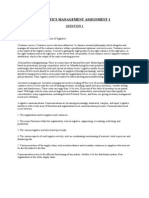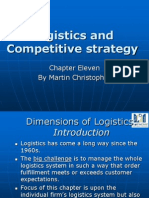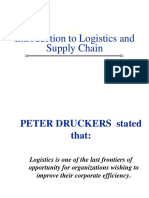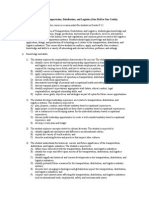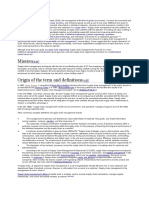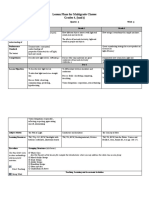Supply Chain Management
(
SCM
) is the management of the flow of goods. It includes the movement and storage of raw materials, work-in-process inventory, and finished goods from point of origin to point of consumption. Interconnected or interlinked networks, channels andnode businesses are involved in the provisionof products and services required by end customers in a supply chain.
"upply chain management has been defined as the #design, planning,e$ecution, control, and monitoring of supply chain activities with theob%ective of creating net value, building a competitive infrastructure,leveraging worldwide logistics, synchroni&ing supply with demand andmeasuring performance globally.#
" draws heavily from the areas of operationsmanagement, logistics, procurement, and information technology, and
strives for an integrated approach.
Origin of the term and definitions
[edit!+he term #supply chain management# entered the public domainwhen eith liver , a consultant at oo& /llen 0amilton (now "trategy1),
used it in an interview for the 2inancial +imes in 345. +he term was slow

to take hold. It gained currency in the mid-3446s, when a flurry of articlesand books came out on the sub%ect. In the late 3446s it rose to prominenceas a management bu&&word, and operations managers began to use it intheir titles with increasing regularity.
ommonly accepted definitions of supply chain management include:
•
+he management of upstream and downstream value-added flows of materials, final goods, and related information among suppliers,company, resellers, and final consumers.
•
+he systematic, strategic coordination of traditional businessfunctions and tactics across all business functions within a particular company and across businesses within the supply chain, for thepurposes of improving the long-term performance of the individualcompanies and the supply chain as a whole
•
/ customer-focused definition is given by 0ines (66*:p98): #"upplychain strategies require a total systems view of the links in the chain thatwork together efficiently to create customer satisfaction at the end pointof delivery to the consumer. /s a consequence, costs must be loweredthroughout the chain by driving out unnecessary e$penses, movements,and handling. +he main focus is turned to efficiency and added value, or the end-user;s perception of value. <fficiency must be increased, andbottlenecks removed. +he measurement of performance focuses ontotal system efficiency and the equitable monetary reward distribution tothose within the supply chain. +he supply chain system must beresponsive to customer requirements.#
•
+he integration of key business processes across the supply chain for the purpose of creating value for customers and stakeholders (=ambert,665)
•
/ccording to the ouncil of "upply hain anagement>rofessionals (">), supply chain management encompasses theplanning and management of all activities involved
in sourcing, procurement, conversion, and logistics management. It also
includes coordination and collaboration with channel partners, whichmay be suppliers,intermediaries, third-party service providers,
or customers. "upply chain management integrates supply and
demand management within and across companies. ore recently, theloosely coupled, self-organi&ing network of businesses that cooperate toprovide product and service offerings has been called the
. / supply chain, as opposed to supply chain management, is a set of organi&ations directly linked by one or more upstream and downstreamflows of products, services, finances, or information from a source to acustomer. "upply chain management is the management of such a chain.
"upply chain management software includes tools or modules used toe$ecute supply chain transactions, manage supplier relationships, andcontrol associated business processes."upply chain event management ("<) considers all possible events andfactors that can disrupt a supply chain. ?ith "<, possible scenarios canbe created and solutions devised.In many cases the supply chain includes the collection of goods after consumer use for recycling. Including third-party logistics or other gatheringagencies as part of the @ re-patriation process is a way of illustrating thenew endgame strategy...
Functions
[edit!"upply chain management is a cross-functional approach that includesmanaging the movement of raw materials into an organi&ation, certainaspects of the internal processing of materials into finished goods, and themovement of finished goods out of the organi&ation and toward the endconsumer. /s organi&ations strive to focus on core competencies andbecoming more fle$ible, they reduce their ownership of raw materialssources and distribution channels. +hese functions are increasingly beingoutsourced to other firms that can perform the activities better or more costeffectively. +he effect is to increase the number of organi&ations involved in
satisfying customer demand, while reducing managerial control of dailylogistics operations. =ess control and more supply chain partners led to thecreation of the concept of supply chain management. +he purpose of supply chain management is to improve trust and collaboration amongsupply chain partners, thus improving inventory visibility and the velocity of inventory movement.
Importance
[edit!rgani&ations increasingly find that they must rely on effective supplychains, or networks, to compete in the global market and networkedeconomy.
In >eter Arucker;s (3445) new management paradigms, thisconcept of business relationships e$tends beyond traditional enterpriseboundaries and seeks to organi&e entire business processes throughout avalue chain of multiple companies.In recent decades, globali&ation, outsourcing, and informationtechnology have enabled many organi&ations, such as Aell and 0ewlett
>ackard, to successfully operate collaborative supply networks in whicheach speciali&ed business partner focuses on only a few key strategicactivities ("cott, 344'). +his inter-organisational supply network can beacknowledged as a new form of organisation. 0owever, with thecomplicated interactions among the players, the network structure fitsneither #market# nor #hierarchy# categories (>owell, 3446). It is not clear what kind of performance impacts different supply network structures couldhave on firms, and little is known about the coordination conditions andtrade-offs that may e$ist among the players. 2rom a systems perspective, acomple$ network structure can be decomposed into individual componentfirms (Bhang and Ailts, 66*). +raditionally, companies in a supply networkconcentrate on the inputs and outputs of the processes, with little concernfor the internal management working of other individual players. +herefore,the choice of an internal management control structure is known to impactlocal firm performance (int&berg, 3494).In the 3st century, changes in the business environment have contributedto the development of supply chain networks. 2irst, as an outcome of globali&ation and the proliferation of multinational companies, %oint









